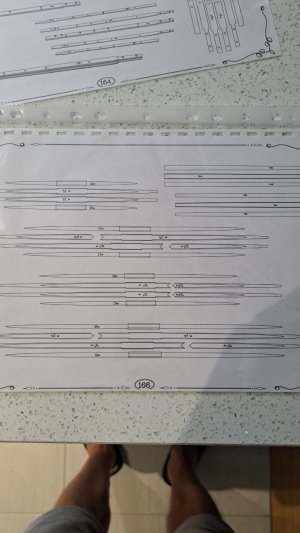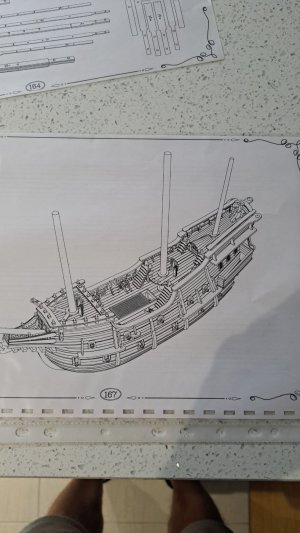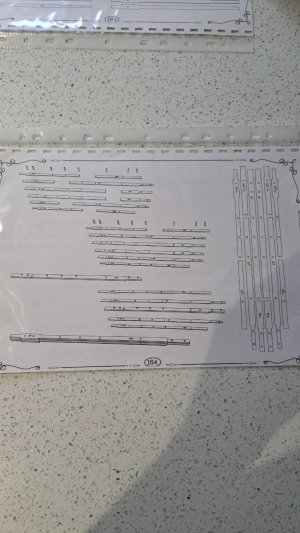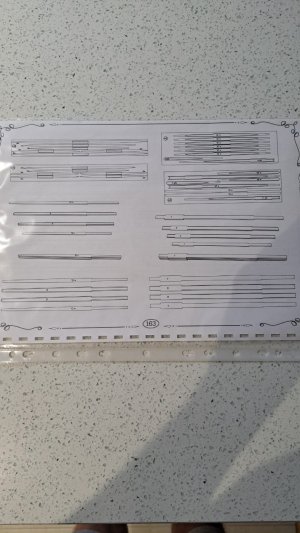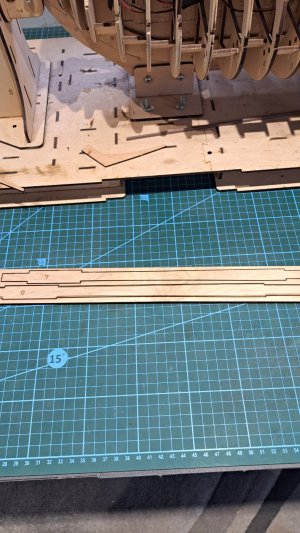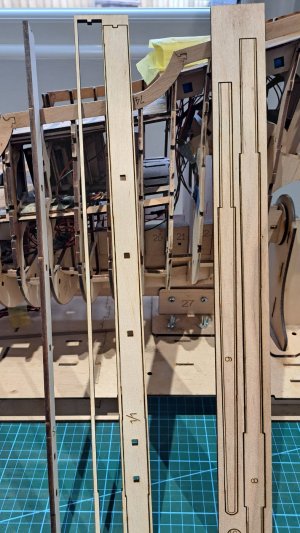-

Win a Free Custom Engraved Brass Coin!!!
As a way to introduce our brass coins to the community, we will raffle off a free coin during the month of August. Follow link ABOVE for instructions for entering.
You are using an out of date browser. It may not display this or other websites correctly.
You should upgrade or use an alternative browser.
You should upgrade or use an alternative browser.
I haven't but what seems to be your problem? Can you post a picture and tell us why you are having trouble with it? Lots of good info on here but we need more explanation from you?
Not a problem as yet. For the reason I have not made a start on the masts I was just putting it out there ready for when I do forward thinking it is what it's called.I haven't but what seems to be your problem? Can you post a picture and tell us why you are having trouble with it? Lots of good info on here but we need more explanation from you?
Are the masts made up or are they dowels of wood? I'm assuming it's a wood model kit. Lots of interest in your masts. Everyone is looking because masts do give us problems from time to time. I'm figuring out how to taper the mast dowels on my present project.
Assuming you are working with a dowel if you have a small plane or cabinet scraper you can shave the mast to taper it forming an octagon or even a hexadecagon than sand it round. I agree with Sutty that chucking it in a drill is a huge help for the final sanding.I'm figuring out how to taper the mast dowels on my present project.
Allan
Different types of wood also I believe@Sutty, do you know the difference between the V1 and V2 of the San Bartolome? I'm looking for a way to tell the difference from US provider. Obviously, I would like to get the v2.
Very interesting way for making the masts - and in my opinion could be an additional step to historical and techincal correctness
Original real masts were constructed
The main reason of a mast construction was simple and had two reasons, an I do not know which one was the most important.
1) A composit construction of the mast cross section is able to take more forces
and
2) there were not enough trees which were streight over the complete height and produce the correct thickness over the total height, which can be used for a mast

this is the main mast of the HMS Victory, the height of the mast over waterline is 62,5 meter (red) - in green is shown the height of the biggest mast element, which is appr. 40 meter long
Take a look at this topic for better understanding
Coming back to the kit masts - these elements have to be glued together and after the glue is dry to sand to the final form - and they will look more realistic - much more than they would be turned from a single dowel - I like this idea very much
Original real masts were constructed
The main reason of a mast construction was simple and had two reasons, an I do not know which one was the most important.
1) A composit construction of the mast cross section is able to take more forces
and
2) there were not enough trees which were streight over the complete height and produce the correct thickness over the total height, which can be used for a mast
this is the main mast of the HMS Victory, the height of the mast over waterline is 62,5 meter (red) - in green is shown the height of the biggest mast element, which is appr. 40 meter long
Take a look at this topic for better understanding
HMS Terror
Hello, I am doing a model of the HMS Terror, I have two drawings from the National Maritime Museum in Greenwich England and the book “HMS Terror” by Betts but neither answers some questions I have. What material was used for the windlass, capstan and winches? The drawings I have do not have a...
shipsofscale.com
Coming back to the kit masts - these elements have to be glued together and after the glue is dry to sand to the final form - and they will look more realistic - much more than they would be turned from a single dowel - I like this idea very much
Very interesting, more things to learn today (well, as usual in this forum).Very interesting way for making the masts - and in my opinion could be an additional step to historical and techincal correctness
Original real masts were constructed
The main reason of a mast construction was simple and had two reasons, an I do not know which one was the most important.
1) A composit construction of the mast cross section is able to take more forces
and
2) there were not enough trees which were streight over the complete height and produce the correct thickness over the total height, which can be used for a mast

this is the main mast of the HMS Victory, the height of the mast over waterline is 62,5 meter (red) - in green is shown the height of the biggest mast element, which is appr. 40 meter long
Take a look at this topic for better understanding
HMS Terror
Hello, I am doing a model of the HMS Terror, I have two drawings from the National Maritime Museum in Greenwich England and the book “HMS Terror” by Betts but neither answers some questions I have. What material was used for the windlass, capstan and winches? The drawings I have do not have a...shipsofscale.com
Coming back to the kit masts - these elements have to be glued together and after the glue is dry to sand to the final form - and they will look more realistic - much more than they would be turned from a single dowel - I like this idea very much
Yeah it's going to be a mission trying to sand square to round I have a mini lathe I will look into placing the mast in there.Very interesting way for making the masts - and in my opinion could be an additional step to historical and techincal correctness
Original real masts were constructed
The main reason of a mast construction was simple and had two reasons, an I do not know which one was the most important.
1) A composit construction of the mast cross section is able to take more forces
and
2) there were not enough trees which were streight over the complete height and produce the correct thickness over the total height, which can be used for a mast

this is the main mast of the HMS Victory, the height of the mast over waterline is 62,5 meter (red) - in green is shown the height of the biggest mast element, which is appr. 40 meter long
Take a look at this topic for better understanding
HMS Terror
Hello, I am doing a model of the HMS Terror, I have two drawings from the National Maritime Museum in Greenwich England and the book “HMS Terror” by Betts but neither answers some questions I have. What material was used for the windlass, capstan and winches? The drawings I have do not have a...shipsofscale.com
Coming back to the kit masts - these elements have to be glued together and after the glue is dry to sand to the final form - and they will look more realistic - much more than they would be turned from a single dowel - I like this idea very much
Yeah it's going to be a mission trying to sand square to round I have a mini lathe I will look into placing the mast in there.
It's not so hard:
- you'll be starting with laminated square stock that is already tapered
- use a finger plane to take off 4 corners and create an even octagonal cross section (take off less where the stick is narrower)
- take off 8 corners with a sanding block running longitudinally
- finish with spiral sanding (or mini lathe)
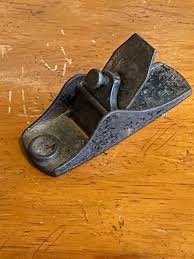
- Joined
- Mar 22, 2024
- Messages
- 394
- Points
- 168

That is true. But very early on tt was learnt that a composite structure with appropriate bolting and banding was stronger than a single piece could ever be. And it was also a way to be sure there were no concealed faults in the heartwood of a single piece. This was particularly important for main and foremasts - single piece masts (called 'pole masts') remained in use for the mizzen for a long time.there were not enough trees which were streight over the complete height and produce the correct thickness over the total height, which can be used for a mast
Thanks Andy, That is a lot of useful information..It's not so hard:
This method parallels, in general, the way masts are made and maintains the proper taper. Picture below shows a finger plane; there are other types available. Fair winds!
- you'll be starting with laminated square stock that is already tapered
- use a finger plane to take off 4 corners and create an even octagonal cross section (take off less where the stick is narrower)
- take off 8 corners with a sanding block running longitudinally
- finish with spiral sanding (or mini lathe)
View attachment 471752
Very informative information never really thought of the technics of boat building before. Master craftsmen back in the day what have we got now CNC machines and robots.That is true. But very early on tt was learnt that a composite structure with appropriate bolting and banding was stronger than a single piece could ever be. And it was also a way to be sure there were no concealed faults in the heartwood of a single piece. This was particularly important for main and foremasts - single piece masts (called 'pole masts') remained in use for the mizzen for a long time.
- Joined
- Mar 22, 2024
- Messages
- 394
- Points
- 168

Actually as well as stronger, much stiffer. Layered structures are harder to bend than single thicknesses as well as stronger. They probably picked that trick up from looking at laminated crossbows. The study of the interaction between military technology and civilian applications is a hobby horse of mine. I could bore you for days on the topic.




